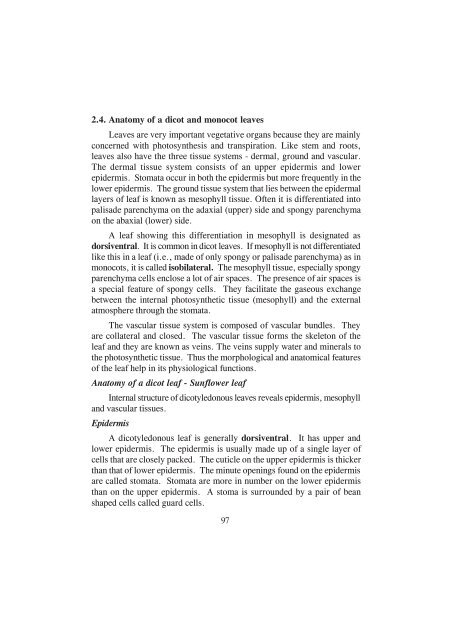BOTANY Higher Secondary Second Year - Textbooks Online
BOTANY Higher Secondary Second Year - Textbooks Online
BOTANY Higher Secondary Second Year - Textbooks Online
Create successful ePaper yourself
Turn your PDF publications into a flip-book with our unique Google optimized e-Paper software.
2.4. Anatomy of a dicot and monocot leaves<br />
Leaves are very important vegetative organs because they are mainly<br />
concerned with photosynthesis and transpiration. Like stem and roots,<br />
leaves also have the three tissue systems - dermal, ground and vascular.<br />
The dermal tissue system consists of an upper epidermis and lower<br />
epidermis. Stomata occur in both the epidermis but more frequently in the<br />
lower epidermis. The ground tissue system that lies between the epidermal<br />
layers of leaf is known as mesophyll tissue. Often it is differentiated into<br />
palisade parenchyma on the adaxial (upper) side and spongy parenchyma<br />
on the abaxial (lower) side.<br />
A leaf showing this differentiation in mesophyll is designated as<br />
dorsiventral. It is common in dicot leaves. If mesophyll is not differentiated<br />
like this in a leaf (i.e., made of only spongy or palisade parenchyma) as in<br />
monocots, it is called isobilateral. The mesophyll tissue, especially spongy<br />
parenchyma cells enclose a lot of air spaces. The presence of air spaces is<br />
a special feature of spongy cells. They facilitate the gaseous exchange<br />
between the internal photosynthetic tissue (mesophyll) and the external<br />
atmosphere through the stomata.<br />
The vascular tissue system is composed of vascular bundles. They<br />
are collateral and closed. The vascular tissue forms the skeleton of the<br />
leaf and they are known as veins. The veins supply water and minerals to<br />
the photosynthetic tissue. Thus the morphological and anatomical features<br />
of the leaf help in its physiological functions.<br />
Anatomy of a dicot leaf - Sunflower leaf<br />
Internal structure of dicotyledonous leaves reveals epidermis, mesophyll<br />
and vascular tissues.<br />
Epidermis<br />
A dicotyledonous leaf is generally dorsiventral. It has upper and<br />
lower epidermis. The epidermis is usually made up of a single layer of<br />
cells that are closely packed. The cuticle on the upper epidermis is thicker<br />
than that of lower epidermis. The minute openings found on the epidermis<br />
are called stomata. Stomata are more in number on the lower epidermis<br />
than on the upper epidermis. A stoma is surrounded by a pair of bean<br />
shaped cells called guard cells.<br />
97
















